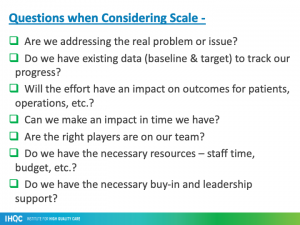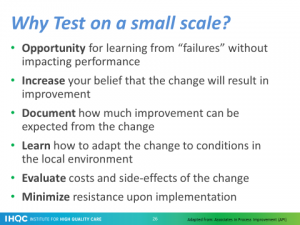
The magnitude and speed of changes over the past month have been crucial and daunting. As the focus shifts to what’s next, our vision may be on a grand scope – getting everything back to “normal” – but our efforts need to be tempered with considerations about the overall scale of the next steps. What can be accomplished? By when? With what resources?
For this week’s Thursday Thoughts, we’re considering Scope and Scale – how to scale our efforts; leverage small steps; and remember that with any change, those impacted may need more time to adjust.
Consider the Scale
With any program design, we typically have a large-scale vision with lofty goals – healthier, happier patients, seamless workflows, etc. While articulating a mission/vision at this level is crucial, specific improvement and implementation efforts need to be right-set and focused at a scale that is realistic and motivating to accomplish.
For example, at the “10,000 ft view,” our vision may be to have healthier communities. Within that vision, our strategic goal is to improve our overall chronic care management. But within that goal, improving the scheduling processes for our diabetics may be the right scale for our initial project efforts. It is realistic and attainable.
This checklist can help guide teams through important scale considerations and conversations (print or download here). Are you addressing your actual problem? What sort of impact will this have on your team, staff, patients, or clinic operations? How much time do you have? Do you have the necessary resources for this project?
Leverage Smaller Steps
 Every improvement model and implementation framework stresses small steps – the PDSA, prototyping, piloting, etc. These small steps help to optimize the changes, avoid missteps, evaluate costs and side-effects, and ultimately build buy-in and acceptance for the changes.
Every improvement model and implementation framework stresses small steps – the PDSA, prototyping, piloting, etc. These small steps help to optimize the changes, avoid missteps, evaluate costs and side-effects, and ultimately build buy-in and acceptance for the changes.
Small steps can still be applied without delaying the urgency of the effort. For example:
- Pilot a telehealth platform that worked well for the behavioral health staff with 1 case manager or health educator for 3 or 4 days, each day making small tweaks before rolling it out throughout the organization.
- Test messages about updates to appointment availability with a few patients first – ask them what was confusing, what questions they still have – before you text or email all patients.
Allow Time To Adjust To Change

While we all had to adapt rapidly to the changes brought on by COVID-19, scaling and pacing our next steps can provide time and reassurance to better manage the natural reactions to the changes yet to come. As you test and scale next steps, be sure to communicate – frequently and openly.
Carefully set your Scope and Scale, leverage your experience with small tests and piloting, and support your team’s natural reactions to change and you will be ready to do the impossible!
If you’d like to share a story of your improvement work, a resource that you find helpful, or just a quick note, please reach out to us at info@IHQC.org.
